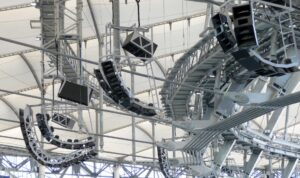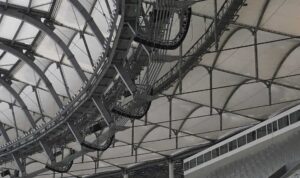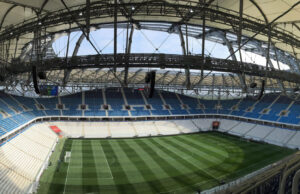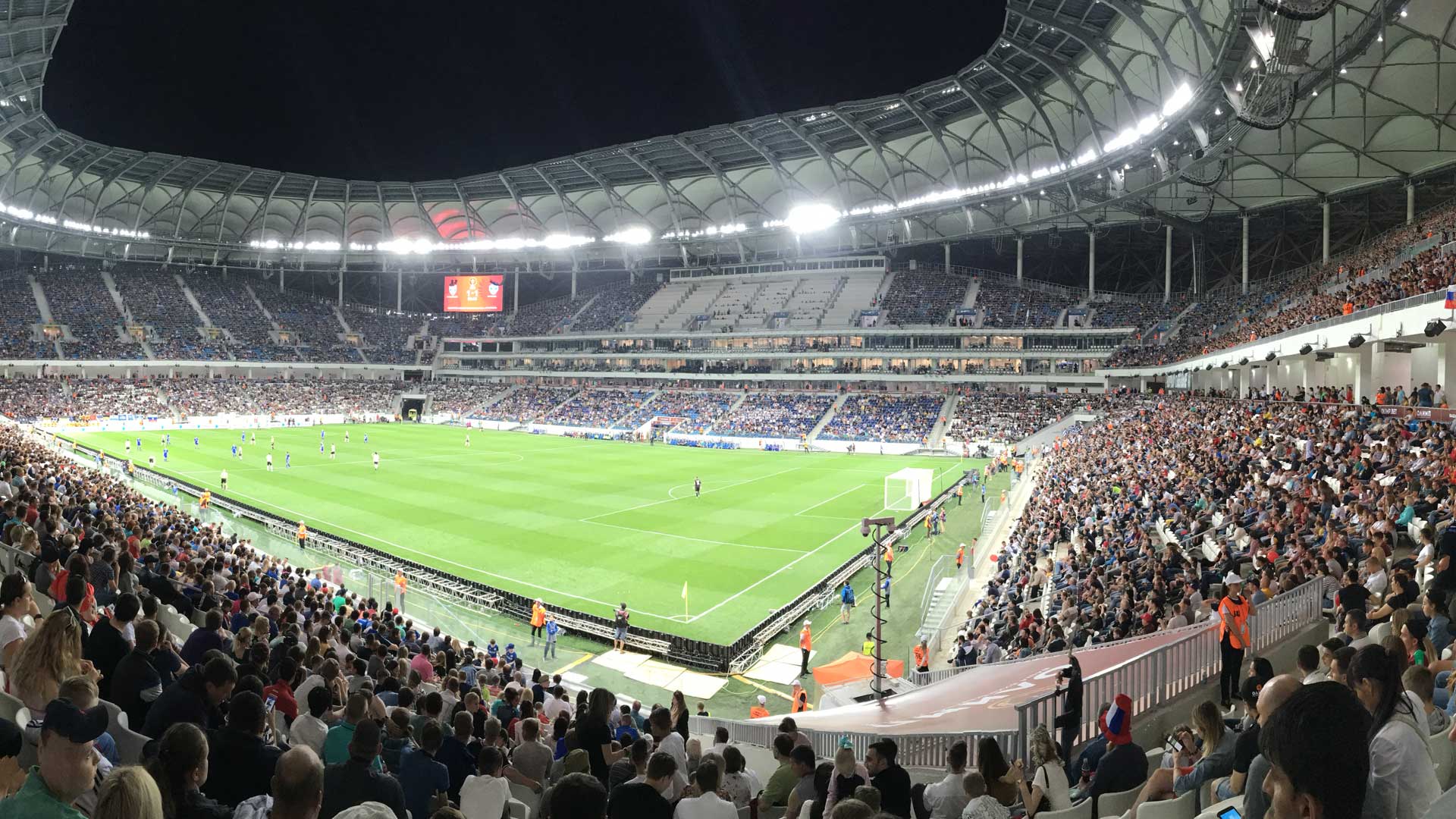Funktion One equips the Volgograd stadium!
The 2018 World Cup ended with a thrilling French victory. And at Solution One, we had another (equally important) reason to be proud: Funktion One equipped the huge Volgograd (formerly Stalingrad) stadium!
A magnificent achievement, which illustrates the brand’s ability to win major contracts when competing with the larger groups that also participated in this complex call for tenders… Just imagine: with a diameter of 303 metres, the stadium has a capacity of 45,000 seats, including 2,280 in the media area and 640 for VIPs, along with 460 accessible seats, with the façade, roof and bowl designed as three independent structural systems. Delivering high quality sound in this space therefore required tremendous expertise on the part of the team behind the stadium’s huge Funktion-One sound system!

The operation was led by Andrei Kremenchugskly, Technical Director of Edelweiss Audio – also known as Funktion-One Russia – who works closely with the UK headquarters. Admittedly, it was not Edelweiss Audio’s first attempt, having previously installed the sound systems for the 2014 Olympic Winter Games in Sochi and then those of the Krasnodar Arena, a stadium considered at the time to be the most technically advanced in Russia, in 2016! Nonetheless… “I saw my guys install the speakers at minus 20° Celsius, in conditions so cold that even the cables snapped when we tried to adjust them…”
Andrei recounts by way of anecdote, before going on to explain that the complications went well beyond the weather conditions. Deadlines were complicated to meet, for example. Although the Volgograd project was part of a series of projects at major sports venues, it represented a huge challenge, with considerable logistical constraints, both in terms of the volume of equipment to be produced and the need to ensure a flawless shipment from Great Britain to Russia within a very tight deadline. “Funktion One did a truly great job, shortening the production phase by an entire month, from 18 weeks to 14 weeks,” Andrei says. “Add to that the numerous performance criteria set by FIFA, which had to be strictly respected given that this was an official World Cup site!”

Meeting the precise criteria set by FIFA
According to the new FIFA standards, crowds gathered around football events can reach levels of 110 dB SPL, particularly since the emergence of vuvuzelas, a kind of extremely loud trumpet used by supporters that greatly disrupted broadcasts of matches and delighted fans during the last World Cup in South Africa! The audio system therefore had to be able to overcome the noise of the crowd and their gadgets by at least 6 dB, with variations in the overall sound level in the spectators’ area not exceeding +/- 3 dB. In addition, the volume of the sound system had to be able to increase with crowd noise to ensure the intelligibility of the voice announcements, without exceeding the SPL of 125 dB, and the frequency response in the seating areas had to be at least 120Hz. at 5kHz +/- 3dB. It was also necessary to be able to reproduce music with an extended frequency response between 40Hz and 120Hz + 6dB / -3dB and between 5kHz and 12kHz +/- 4dB, and to provide a sufficient margin to compensate for high frequency atmospheric losses.
The Funktion-One design team therefore worked on simulations and modelling in EASE to ensure that these criteria were met, taking into account the stadium’s architectural plans. This made it possible to determine the optimal configurations and positions of the Evo series speakers, which was then combined with Funktion-One’s renowned bass technology. The result? A sound system that meets FIFA’s criteria and offers visitors a first-class listening experience, with 638 Funktion-One speakers and 50 MC2 audio amplifiers! Andrei explains: “The support of headquarters was essential. They were present from the very conception of the project because FIFA’s conditions are very strict… to such an extent that everything had to be customised. And when we reached the final phase of the installation, John Newsham and David Brumel came to the site. They also met with the person in charge of inspection for FIFA…”

Precise, homogeneous, intelligible sound coverage
The precise directionality of the speakers, oriented with custom-made metal parts – with 24 C-shaped clusters along the sides and 12 Y-shaped clusters for the corners – was a major asset in meeting these criteria. Evo clusters have a very powerful directivity control, both in horizontal and vertical planes, resulting in homogeneous sound coverage. The combination of midrange and bass speakers also produced powerful all-round bass levels which, when combined with the Evos, enabled the system to provide a balanced response, even at very high sound pressure levels. In addition, the system needed to provide exceptional clarity and intelligibility for voice announcements, which can include extremely important security announcements, as well as truly immersive comprehensive music reproduction to enhance the match day experience for fans.
Given the system specifications, the design team also needed Dante-compatible amplification that would preserve the sound quality of the Funktion-One speakers. They therefore naturally turned to MC2 Audio, a trusted partner for many years, who once again lived up to their high expectations. MC2 Audio’s 50 Delta OEM amplifiers, all with quadruple output, providing 200 channels of DSP and amplification, with total power of just under 500 kW, were all connected via Ethernet and configured using the software AudioCore: Amped Edition. This offers a revolutionary new feature: architecture grouping. As a result, the Evos, F215s and F121s, as well as F81s and F101s, were grouped together to minimise system’s complexity. This formula hit the nail on the head, simplifying it from 212 channels to just eight sets of grouped controls!
“It was crucial to have several levels of control,” Andrei Kremenchugskly explains. “Of course, we installed the system with the World Cup in mind, but we wanted to offer a system that could be adapted to other uses. For example, it is possible to disconnect entire clusters within the stadium if it is not fully occupied. When there is a local match that attracts fewer people, for example. We had to do this segmentation work anyway. For the World Cup, we had to customise the handling of the zones. The one devoted to the media, for example, should have a certain calmness about it and not broadcast the sound at the same volume, except during the anthems of course!”
The sound installation at the Volgograd Arena was only possible thanks to the commitment and dedication of everyone involved. The production team at Funktion-One’s headquarters in Surrey, England, was instrumental in this. This project required close cooperation, the support of the company’s suppliers and confidence that every link in the production chain could be relied on to perform well. The order was shipped in three consignments during November 2017, with a delay of just 14 weeks between the placement of the order and the supply of all the equipment, which was not very long at all! With meticulous planning, everything was delivered on time and the result was amazing, providing an immersive sound experience and audio precision that is rarely found in stadiums… So yes, we are proud of the World Cup in more ways than one, because it proves the extreme effectiveness of our products and the immeasurable talent of our partners!
SHARE



